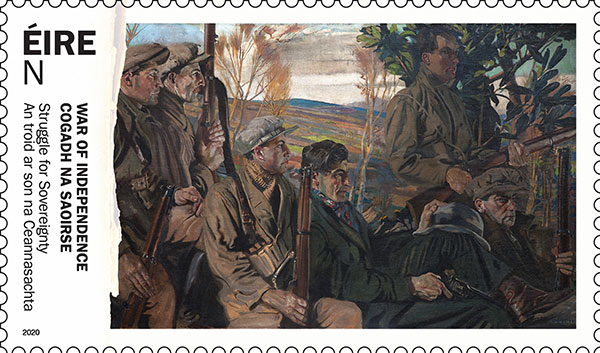Men of the South—a re-evaluation
Published in Issue 3 (May/June 2020), News, Volume 28By Joe Buckley
An Post’s stamp commemorating Ireland’s War of Independence features Seán Keating’s Men of the South. The original work hangs in the Crawford Art Gallery, Cork. Keating painted two associated sketches, both featuring Seán Moylan, leader of the North Cork flying column: one entitled 1921—An I.R.A. Column, which hangs in Áras an Uachtaráin, and a sister sketch purchased from the artist as a gift for Moylan’s wife, Nora.
Several sources indicate that these works were painted between the Truce (July) and the Treaty (December) in 1921. Internal evidence in each work, however, establishes the impossibility of the pictures having been painted during those months of relative calm. The works were created in the turbulent ‘post-split’ period, between ratification of the Treaty by the Dáil on 7 January 1922 and 3 April 1922, when Men of the South was shown at the annual RHA exhibition. From early 1922 the spectre of civil war hovered over the political landscape. Keating’s friend, Austin Clarke, perceived the gathering gloom and in ‘The Lost Heifer’ articulated apprehension as ‘the mist becoming rain’.
Keating conceived the notion of painting the column while working on a portrait of Moylan in the autumn of 1921 after Moylan’s release from custody upon his election to the second Dáil. The artist wrote to Michael McDunphy (Uachtarán na hÉireann’s secretary) on 3 January 1951: ‘When I had finished Moylan’s portrait I told him that I would like to paint the column and before leaving me he promised to fix it’. After Moylan’s men turned up armed at the College of Art ‘several months later’, Keating was ordered out of the College. He relates to McDunphy that he then obtained space in the Mansion House, and had difficulty moving his canvas and apparatus with the column and its artefacts. With his men and weapons ensconced in the Mansion House, Seán Moylan had infiltrated the very building where the Dáil sat with a crack armed column. Was the project entirely innocent, or was it, in the turbulence of the time, a display of the fearless bravura that made Moylan’s name synonymous with daring military strategy in North Cork? In the event, Keating found the light in the Mansion House unsatisfactory, and he moved back to the College of Art, smuggling in Moylan’s men with their concealed weapons.

Critically, Keating excludes Moylan from the completed work, replacing him as the focus of the picture with the figure of Roger Kiely. When considered in conjunction with its sister sketches, the omission of Moylan is a significant factor contributing to the calm and restraint of Men of the South. In Witness Statement 505 for the Bureau of Military History (BMH), Moylan remarks that ‘[Keating] took a particular fancy to Roger Kiely, a schoolteacher’, continuing: ‘Strangely enough, this man, while a Volunteer, was not a fighting man in the sense that the others were’. Writing to McDunphy, Keating says of his subject, ‘Roger Kiely was about the best and finest man I ever knew’. There is something peculiarly Irish and superbly ironic—which was not lost on Keating—in having the portrait of a very fine individual who eschewed active participation and who, as a matter of certainty, never lifted a firearm in anger in his lifetime personify and represent the quintessence of a leader of ‘the boys’ who fought Ireland’s War of Independence.
It has been suggested that the painting was conceived and executed not as partisan propaganda but rather, in the tradition of Keating’s mentor Orpen, as a commemorative historical record as distinct from a celebration of war. If there is one quality more than another that Keating infuses into the work and into the gaze of his subjects in Men of the South, it is Clarke’s ‘mist becoming rain’.
In BMH Witness Statement 1351 (8 February 1956), Roger Kiely’s neighbour, Humphrey O’Donoghue, relates that Kiely was rounded up with O’Donoghue on 11 June 1921 and brought to Spike Island. In 2019 two of Roger Kiely’s children visited the island and told The Corkman (4 October 2019) that Seán Keating took artistic licence in depicting their father holding a revolver, since, on Seán Moylan’s orders, he served as an intelligence officer and did not take part in an ‘active service’. They remembered that their father rarely spoke of ‘the Troubles’, but recalled him telling of his arrest while teaching at the National School in Cullen, adding: ‘Christmas Eve never passed without mention that this was the night in 1921 when he arrived home following months of internment’. Roger Kiely’s internment on Spike Island from June to Christmas 1921 precluded the possibility of Seán Keating’s having painted Men of the South before 1922.
An Post’s commemorative stamp is a timely reminder of the heroic young Irish men and women who exhausted the enterprise of an empire.
Joe Buckley is a UCD history graduate and founding member of the Parnell Summer School at Avondale. He is a former teacher and member of the Incorporated Law Society.
















